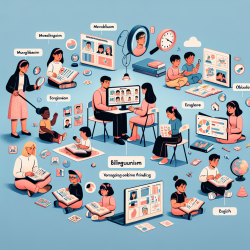Introduction
In the dynamic field of speech-language pathology, data-driven decisions are crucial for effective practice. The research article "A Narrative Approach to Synthesizing Research on Vietnamese Bilingual and Monolingual Children" by Giang T. Pham provides valuable insights that can enhance the skills of practitioners working with bilingual children. This blog explores the key findings and implications of this research, emphasizing the importance of understanding bilingual language development and disorders.
Key Findings from the Research
The research conducted by Pham offers a comprehensive synthesis of over 15 years of data on Vietnamese-speaking children. The main findings focus on three areas:
- Typical Bilingual Development: The study highlights that English develops rapidly and often surpasses the first language (L1) over time. However, with adequate support, L1 development can continue alongside English.
- Reading Performance in Vietnam: Vietnamese children learn to read accurately and fluently by the end of the first grade. Rapid automatized naming and phonological awareness in kindergarten are strong predictors of reading fluency in first grade.
- Characteristics of Developmental Language Disorder (DLD): Vietnamese children with DLD exhibit limited vocabulary, shorter sentences, and more grammatical errors. Tools like nonword and sentence repetition are effective in identifying DLD.
Implications for Practitioners
Practitioners can enhance their skills by integrating these findings into their practice. Here are some practical applications:
- Support for L1 Development: Encourage parents to maintain the use of the first language at home. This support can help preserve cultural identity and strengthen family bonds.
- Early Screening and Intervention: Utilize tools like rapid automatized naming and phonological awareness assessments to identify children at risk of reading difficulties early on.
- Accurate Diagnosis of DLD: Implement nonword and sentence repetition tasks to improve the accuracy of DLD diagnosis in Vietnamese-speaking children.
Encouraging Further Research
The research by Pham also serves as an invitation for further exploration in the field. Practitioners and researchers are encouraged to delve deeper into the nuances of bilingual language development and disorders. This ongoing research can lead to more refined assessment tools and intervention strategies, ultimately benefiting children from diverse linguistic backgrounds.
Conclusion
By understanding the findings from Pham's research, practitioners can make informed, data-driven decisions that enhance the outcomes for bilingual children. The integration of these insights into practice not only improves diagnostic accuracy but also supports the holistic development of children's language skills.
To read the original research paper, please follow this link: A Narrative Approach to Synthesizing Research on Vietnamese Bilingual and Monolingual Children.










